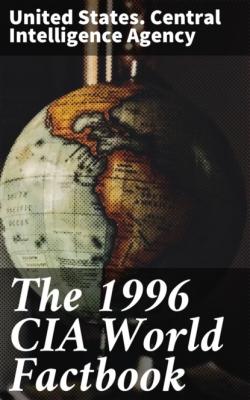The 1996 CIA World Factbook. United States. Central Intelligence Agency
Читать онлайн.| Название | The 1996 CIA World Factbook |
|---|---|
| Автор произведения | United States. Central Intelligence Agency |
| Жанр | Социология |
| Серия | |
| Издательство | Социология |
| Год выпуска | 0 |
| isbn | 4057664582324 |
GDP per capita: $22,100 (1995 est.)
GDP composition by sector: agriculture: 3.1% industry: 27.7% services: 69.2% (1994)
Inflation rate (consumer prices): 4.75% (1995)
Labor force: 8.63 million (September 1991) by occupation: finance and services 33.8%, public and community services 22.3%, wholesale and retail trade 20.1%, manufacturing and industry 16.2%, agriculture 6.1% (1987)
Unemployment rate: 8.1% (December 1995)
Budget:
revenues: $95.69 billion
expenditures: $95.15 billion, including capital expenditures of $NA
(FY95/96 est.)
Industries: mining, industrial and transportation equipment, food
processing, chemicals, steel
Industrial production growth rate: 3.9% (FY93/94)
Electricity: capacity: 34,540,000 kW production: 155 billion kWh consumption per capita: 8,021 kWh (1993)
Agriculture: wheat, barley, sugarcane, fruits; cattle, sheep, poultry
Illicit drugs: Tasmania is one of the world's major suppliers of licit opiate products; government maintains strict controls over areas of opium poppy cultivation and output of poppy straw concentrate
Exports: $51.57 billion (f.o.b., 1995)
commodities: coal, gold, meat, wool, alumina, wheat, machinery and
transport equipment
partners: Japan 25%, US 11%, South Korea 6%, NZ 5.7%, UK, Taiwan,
Singapore, Hong Kong (1992)
Imports: $57.41 billion (f.o.b., 1995) commodities: machinery and transport equipment, computers and office machines, crude oil and petroleum products partners: US 23%, Japan 18%, UK 6%, Germany 5.7%, NZ 4% (1992)
External debt: $147.2 billion (1994)
Economic aid: donor: ODA, $953 million (1993)
Currency: 1 Australian dollar ($A) = 100 cents
Exchange rates: Australian dollars ($A) per US$1 - 1.3477 (January 1996), 1.3486 (1995), 1.3668 (1994), 1.4704 (1993), 1.3600 (1992), 1.2835 (1991)
Fiscal year: 1 July - 30 June
Transportation———————
Railways:
total: 38,563 km (2,914 km electrified; 172 km dual gauge)
broad gauge: 6,083 km 1.600-m gauge
standard gauge: 16,752 km 1.435-m gauge
narrow gauge: 15,728 km 1.067-m gauge
Highways:
total: 810,264 km
paved: 283,592 km (including 1,200 km of expressways)
unpaved: 526,672 km (1989 est.)
Waterways: 8,368 km; mainly by small, shallow-draft craft
Pipelines: crude oil 2,500 km; petroleum products 500 km; natural
gas 5,600 km
Ports: Adelaide, Brisbane, Cairns, Darwin, Devonport, Fremantle,
Geelong, Hobart (Tasmania), Launceton (Tasmania), Mackay, Melbourne,
Sydney, Townsville
Merchant marine:
total: 76 ships (1,000 GRT or over) totaling 2,547,869 GRT/3,679,534
DWT
ships by type: bulk 30, cargo 4, chemical tanker 3, combination bulk
1, container 6, liquefied gas tanker 6, oil tanker 18,
roll-on/roll-off cargo 7, short-sea passenger 1 (1995 est.)
Airports:
total: 442
with paved runways over 3 047 m: 9
with paved runways 2 438 to 3 047 m: 13
with paved runways 1 524 to 2 437 m: 106
with paved runways 914 to 1 523 m: 116
with paved runways under 914 m: 30
with unpaved runways 1 524 to 2 437 m: 22
with unpaved runways 914 to 1 523 m: 146 (1995 est.)
Communications———————
Telephones: 8.7 million (1987 est.)
Telephone system: good domestic and international service domestic: domestic satellite system international: submarine cables to New Zealand, Papua New Guinea, and Indonesia; satellite earth stations - 10 Intelsat (4 Indian Ocean and 6 Pacific Ocean), 2 Inmarsat (Indian and Pacific Ocean Regions)
Radio broadcast stations: AM 258, FM 67, shortwave 0
Radios: NA
Television broadcast stations: 134 (1987 est.)
Televisions: 9.2 million (1992 est.)
Defense———
Branches: Australian Army, Royal Australian Navy, Royal Australian
Air Force
Manpower availability: males age 15–49: 4,848,777 males fit for military service: 4,192,250 males reach military age (17) annually: 127,569 (1996 est.)
Defense expenditures: exchange rate conversion - $7.3 billion, 2.0% of GDP (FY95/96)
======================================================================
@Austria———
Map—
Location: 47 20 N, 13 20 E—Central Europe, north of Italy
Flag——
Description: three equal horizontal bands of red (top), white, and
red
Geography————
Location: Central Europe, north of Italy
Geographic coordinates: 47 20 N, 13 20 E
Map references: Europe
Area:
total area: 83,850 sq km
land area: 82,730 sq km
comparative area: slightly smaller than Maine
Land boundaries:
total: 2,558 km
border countries: Czech Republic 362 km, Germany 784 km, Hungary 366
km, Italy 430 km, Liechtenstein 37 km, Slovakia 91 km, Slovenia 324
km, Switzerland 164 km
Coastline: 0 km (landlocked)
Maritime claims: none (landlocked)
International disputes: none
Climate: temperate; continental, cloudy; cold winters with frequent rain in lowlands and snow in mountains; cool summers with occasional showers
Terrain: in the west and south mostly mountains (Alps); along the eastern and northern margins mostly flat or gently sloping lowest point: Neusiedler See 115 m highest point: Grossglockner 3,797 m
Natural resources: iron ore, oil, timber, magnesite, lead, coal,
lignite, copper, hydropower
Land use:
arable land: 17%
permanent crops: 1%
meadows and pastures: 24%
forest and woodland: 39%
other: 19%
Irrigated land: 40 sq km (1989)
Environment:
